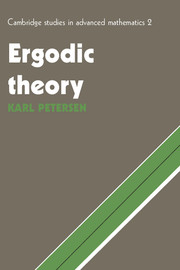4 - More about recurrence
Published online by Cambridge University Press: 05 June 2012
Summary
This chapter presents several further topics concerning recurrence and mixing. First is a direct construction (based on the theory of almost periodic functions) of eigenfunctions for m.p.t.s which are not weakly mixing. The second section presents the purely topological analogues of recurrence, ergodicity, and weak and strong mixing, and the third introduces Furstenberg's theory of multiple recurrence and his proof of the Szemeredi Theorem. In 4.4 we give the Jewett–Bellow–Furstenberg proof of the existence of uniquely ergodic topological representations of ergodic m.p.t.s. The final section examines two examples of weakly mixing m.p.t.s which are not strongly mixing: an example of Kakutani (which we show is not even topologically strongly mixing), and one of Chacon, which is also prime (i.e. without proper invariant sub-σ-algebras). as was discovered by del Junco.
Construction of eigenfunctions
We will give now a more direct proof of the existence of eigenfunctions for m.p.t.s which are not weakly mixing. The idea, apparently due to Varadhan, Furstenberg, and Katznelson, is to reduce the statement to the existence of nontrivial characters on compact abelian groups. However, since this is itself usually proved with the help of the Spectral Theorem for compact operators, we will complete the argument by means of an elementary proof, which also introduces some important ideas from topological dynamics and the theory of almost periodic functions.
- Type
- Chapter
- Information
- Ergodic Theory , pp. 133 - 226Publisher: Cambridge University PressPrint publication year: 1983



